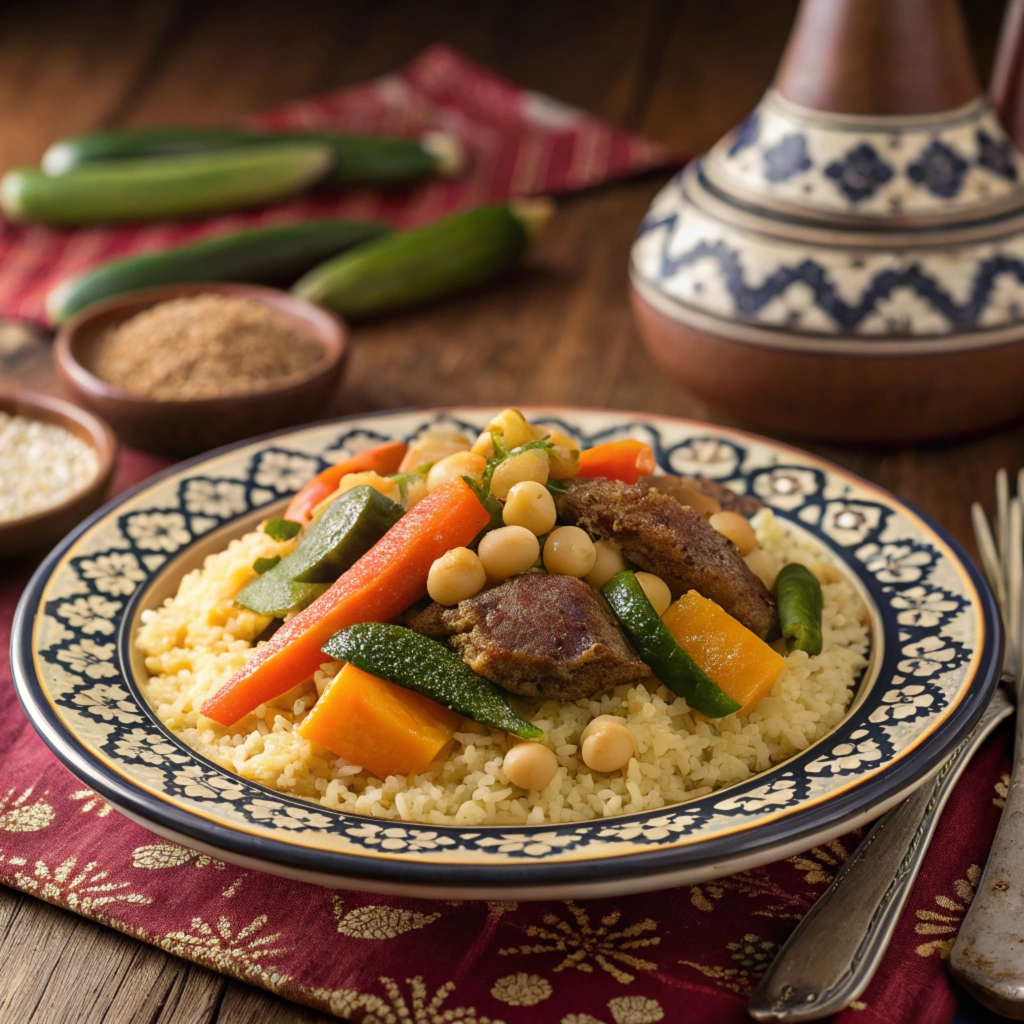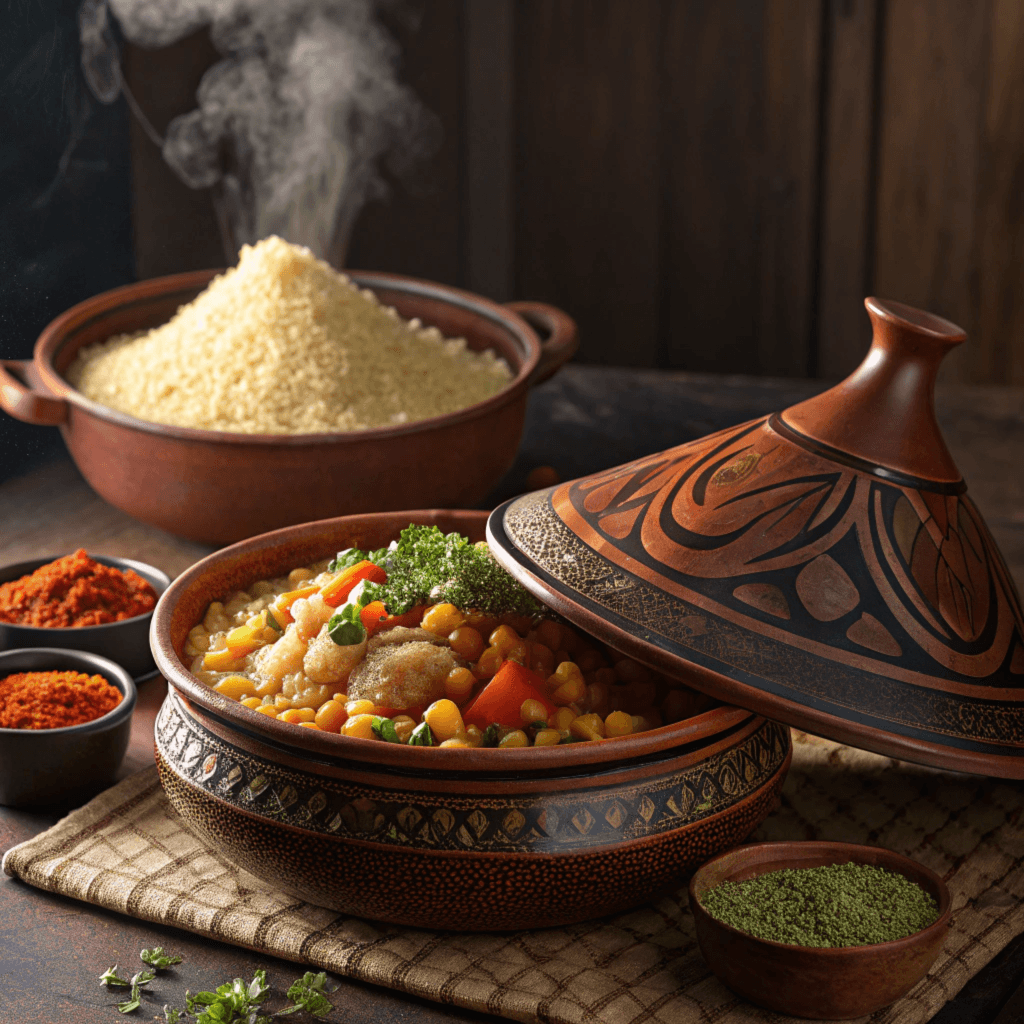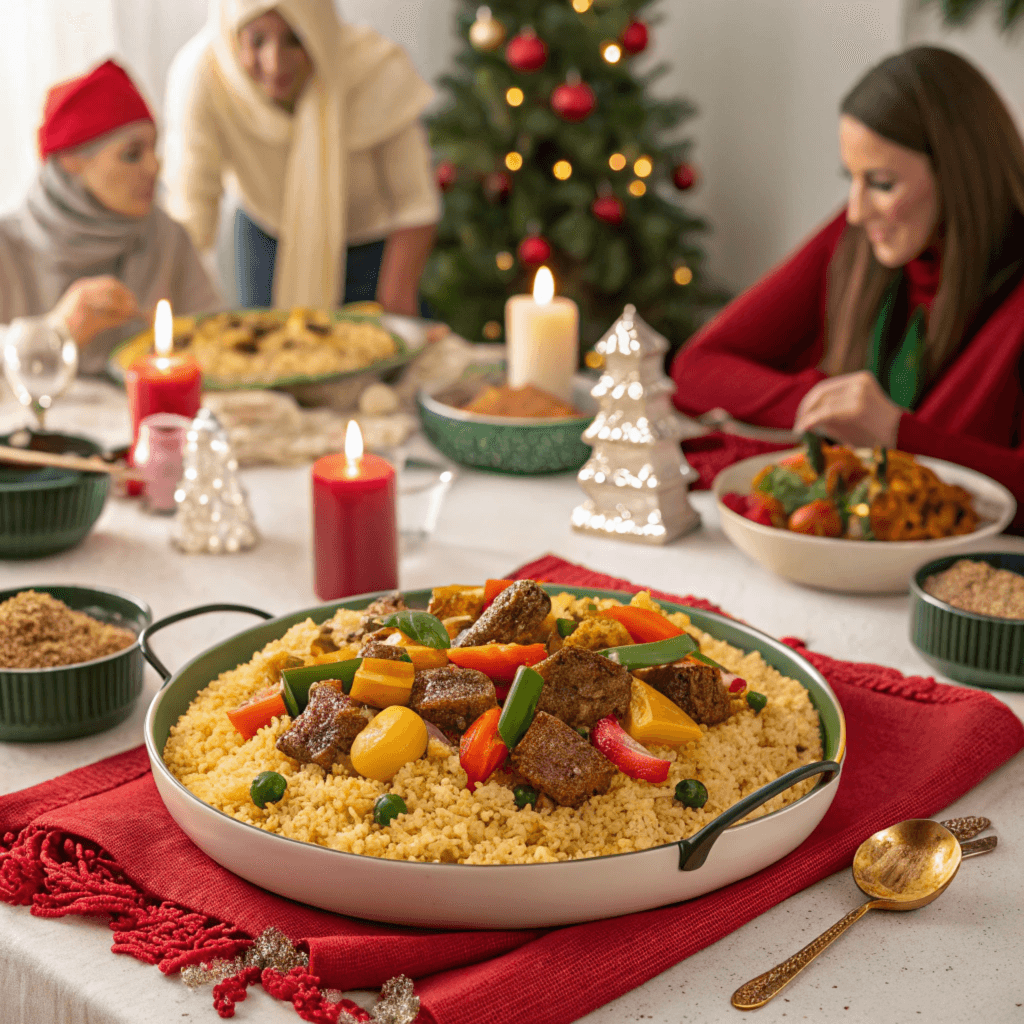
Couscous is more than just a meal in North Africa; it’s a way of life. For centuries, this beloved dish has been a culinary cornerstone, offering nourishment, comfort, and a connection to the region’s rich history and culture. Among the many variations across North African countries, Algerian couscous holds a special place, celebrated for its diversity of flavors and its significance in social and cultural traditions.
What makes Algerian couscous unique is not just the dish itself but the traditions surrounding its preparation and consumption. It’s a dish that tells a story—one of resilience, heritage, and unity. From family gatherings to festive occasions, Algerian couscous embodies the spirit of hospitality and abundance. Let’s explore the origins, ingredients, and preparation methods that make Algerian couscous an irreplaceable staple in Algerian cuisine.
What is Algerian Couscous?
Origins and Cultural Significance
The Berber communities of North Africa introduced Algerian couscous centuries ago, embedding it deeply into their culture and daily lives. Historical records show that families relied on couscous as a staple food long before modern culinary techniques existed. They prepared it as a humble, nutritious meal using locally available ingredients such as semolina flour.
Couscous represents much more than a meal in Algeria—it embodies the country’s identity and traditions. Families across the nation include couscous in their most significant moments, whether during weddings, religious celebrations, or simple everyday gatherings. Algerians view couscous as a symbol of abundance and unity, which is why it takes center stage during holidays like Eid al-Fitr and Eid al-Adha.
Additionally, couscous preparation is a social activity. Women often gather to steam, fluff, and season couscous in large batches, reflecting the communal spirit of Algerian culture. The sharing of this dish during family gatherings or with guests underscores its role as a symbol of hospitality.
What is Algerian Couscous Made Of?
Algerian couscous begins with three fundamental ingredients: semolina, water, and salt. Using time-honored techniques, cooks skillfully transform these simple elements into the signature light, fluffy grains that form the backbone of this iconic dish. What truly defines the uniqueness of Algerian couscous, however, is the assortment of additional ingredients that enhance its flavor and texture. From vibrant vegetables and tender meats to aromatic spices, these additions create a culinary experience that is as diverse as Algeria itself.
Algerian couscous typically features a harmonious blend of ingredients that create its distinct and satisfying flavor.
- Vegetables: Common staples like carrots, zucchini, and turnips are simmered in a spiced broth, adding layers of flavor to the dish.
- Meat: Lamb, chicken, or occasionally beef serves as the protein base, with regional preferences influencing the choice of meat.
- Chickpeas: A key component of Algerian couscous, chickpeas enhance the dish with their texture and nutritional value.
This combination of ingredients results in a well-balanced meal that is both nourishing and flavorful. The dish also incorporates an array of aromatic spices, which contribute to its rich and enticing taste.mon, turmeric, and cumin, which give the broth a warm and aromatic character.
How is Algerian Couscous Prepared?
The Traditional Cooking Method
Traditional preparation involves steaming couscous grains multiple times for the perfect texture. For a detailed look at the preparation of another North African variation, explore Tunisian Couscous with Lamb, a recipe that shares similarities with Algerian techniques.
Typical Ingredients for Algerian Couscous Dishes
The beauty of Algerian couscous lies in its versatility. While the base remains consistent, the ingredients added to the dish vary by region, season, and occasion.
- Vegetables: Algerian couscous almost always includes a medley of vegetables such as carrots, zucchini, turnips, and sometimes potatoes. These are slow-cooked in a spiced broth that forms the heart of the dish.
- Meat: Depending on the occasion, lamb, chicken, or beef may be used. Lamb is often reserved for festive events, while chicken is common for daily meals.
- Spices: The broth is seasoned with cinnamon, paprika, and turmeric, giving it a distinctively rich and aromatic flavor profile.
These ingredients combine to create a dish that is as nourishing as it is flavorful, offering a perfect balance of textures and tastes.
Types of Couscous in Algerian Cuisine
Algerian cuisine boasts a variety of couscous types, each uniquely suited to specific dishes and occasions. While all couscous starts with semolina as its base, the preparation and grain size create distinctive variations that cater to different textures and flavor combinations.
What Are the Two Types of Couscous?
In Algeria, couscous can be broadly categorized into two main types:
- Regular Couscous:
This is the most common type, characterized by its small, fine grains. Regular couscous is versatile and typically served with a rich, spiced broth containing vegetables, meat, or chickpeas. It is a staple for daily meals and is also featured prominently in festive dishes. The light texture makes it ideal for absorbing the flavors of hearty stews or delicate sauces. - Berkoukes (Large Couscous):
Berkoukes is a larger-grain couscous, almost resembling small pearls. Its dense, chewy texture makes it perfect for hearty stews, particularly those served during colder months. Often cooked with lamb, chickpeas, and seasonal vegetables, Berkoukes has a comforting, rustic appeal that distinguishes it from the finer variety.
What is the Difference Between Large and Small Couscous?
The primary differences between regular couscous and berkoukes lie in their texture, preparation methods, and culinary uses.
- Texture:
Regular couscous has a delicate and fluffy consistency, while Berkoukes offers a firmer bite due to its larger grains. - Preparation Methods:
Regular couscous is steamed multiple times to achieve its airy texture, whereas Berkoukes is often boiled directly in the broth for a heartier result. - Dish Pairings:
Regular couscous is commonly paired with vegetable-heavy stews or light meat dishes, making it suitable for everyday meals. Berkoukes, on the other hand, is served with rich, thick stews and is a favorite in the colder months.
Regional preferences also play a role. Coastal areas often favor regular couscous, while the mountainous and rural regions of Algeria lean towards Berkoukes for its robust flavor and satisfying texture.
Algerian Couscous vs. Moroccan Couscous
Though Algerian couscous and Moroccan couscous share similarities, they reflect distinct culinary traditions and regional preferences. Each variation offers unique flavors, preparation techniques, and cultural significance.
What is the Difference Between Moroccan and Algerian Couscous?
- Preparation Techniques:
Algerian couscous is traditionally steamed multiple times for a soft, fluffy texture, while Moroccan couscous often involves quicker steaming or the use of instant couscous, catering to more modern conveniences. - Flavor Profiles:
Algerian couscous typically emphasizes savory flavors, with rich broths made from a combination of spices like turmeric, cinnamon, and paprika. In contrast, Moroccan couscous is known for balancing sweet and savory elements, often featuring ingredients like dried fruits and nuts. - Accompanying Dishes:
Algerian couscous is paired with hearty stews filled with vegetables and meat, such as lamb or chicken. Moroccan couscous frequently includes sweeter accompaniments like caramelized onions or raisins.
These differences highlight how couscous adapts to the diverse culinary identities of North Africa, showcasing regional flavors and traditions.
Popular Algerian Couscous Dishes
Algerian cuisine elevates couscous into an art form, with each dish reflecting a blend of tradition and creativity. Two of the most iconic dishes are Couscous with Seven Vegetables and Sweet Couscous (Mesfouf), each carrying its own cultural significance.
Couscous with Seven Vegetables (Couscous aux Sept Légumes)
This signature dish is the epitome of Algerian couscous, offering a perfect balance of flavors, textures, and symbolic significance. It is typically made with:
- A variety of vegetables: carrots, zucchini, turnips, tomatoes, potatoes, and pumpkin.
- A richly spiced broth infused with turmeric, paprika, and cinnamon.
- A choice of meat, usually lamb or chicken, depending on the occasion.
The name “Seven Vegetables” holds symbolic meaning in Algerian culture, often representing abundance and good fortune. Regional variations may add or substitute ingredients based on local produce and traditions. Whether served during a family dinner or a festive celebration, this dish embodies the essence of Algerian hospitality.
Sweet Couscous (Mesfouf)
In contrast to the savory Couscous with Seven Vegetables, Mesfouf is a sweet, indulgent version often reserved for special occasions. This dish is prepared with:
- Raisins and dates: These add natural sweetness and a chewy texture.
- Butter and sugar: Used to coat the steamed couscous grains for a rich, velvety finish.
- Almonds or other nuts: Sometimes sprinkled on top for added crunch.
Mesfouf plays a significant role during Ramadan and family gatherings, often enjoyed as a comforting dish to break the day’s fast. Its delicate sweetness and straightforward preparation have made it a cherished dessert across generations. Families treasure its ability to bring both flavor and tradition to the table, reinforcing its place in Algerian culinary heritage.
Couscous and Festive Occasions in Algeria
Couscous holds a deeply rooted significance in Algerian celebrations, symbolizing abundance, unity, and hospitality. It’s not just a dish but a cherished cultural tradition that plays a vital role in life’s most memorable moments.
The Role of Couscous in Algerian Celebrations
In In Algeria, couscous is far more than just a meal—it holds a central role in cultural celebrations. Families prepare it with care and generosity during weddings, Eid, and other religious holidays, often in large quantities to ensure there is enough for everyone. Couscous on the table symbolizes hospitality and abundance, values that are deeply ingrained in Algerian traditions.
- Weddings: Couscous is often the star of wedding feasts, served alongside rich stews or delicately spiced meats. It honors the union of two families and sets the tone for a joyous celebration.
- Eid Celebrations: During holidays like Eid al-Fitr and Eid al-Adha, families prepare couscous with lamb or chicken, complemented by a variety of vegetables, to mark these festive occasions.
- Family Gatherings: Couscous also brings loved ones together at reunions, acting as a comforting reminder of the bonds that connect family members across generations.
Sharing couscous during these moments highlights its role as a unifying dish, reflecting Algeria’s cultural emphasis on togetherness and generosity.
How Couscous Brings Families Together
Preparing couscous is often a communal activity, particularly during large family gatherings or holidays. Women traditionally come together to prepare the grains, vegetables, and broth, passing down techniques that have been perfected over generations.
- Communal Preparation: The act of rolling semolina into grains, steaming them to perfection, and assembling the dish is often a group effort. This collaborative process fosters connection and strengthens family bonds.
- Sharing Meals: In Algerian culture, meals are typically served in large communal dishes, where everyone gathers around to share. Couscous, with its hearty portions and comforting flavors, perfectly embodies this tradition of togetherness.
By involving multiple generations in its preparation and serving it to loved ones, couscous becomes a vessel of culture, love, and unity in Algerian households.
Tips for Making Authentic Algerian Couscous

To replicate the authentic flavor and texture of Algerian couscous, attention to detail is key. Here are some essential tips to help you master this iconic dish:
- Choose the Right Semolina: Opt for high-quality semolina flour to ensure light, fluffy grains. Look for coarse semolina for traditional couscous or fine semolina for smoother textures.
- Master the Steaming Technique: Using a couscousière, steam the couscous in stages, fluffing it between each round to prevent clumping. This step is crucial for achieving the airy texture that defines Algerian couscous.
- Balance the Spices: The broth should be flavorful but not overpowering. Use a mix of turmeric, cinnamon, paprika, and cumin, adjusting the levels to suit your taste.
- Cook with Love: Algerian couscous is as much about the process as it is about the result. Take your time and involve family or friends to make the preparation a memorable experience.
By following these steps, you can bring the taste of Algeria to your own kitchen, honoring the traditions that make this dish so special.
Frequently Asked Questions about Couscous
Is Algerian Couscous Gluten-Free?
Traditional Algerian couscous is made from semolina, which is derived from wheat and contains gluten. However, for those with gluten sensitivities, gluten-free alternatives are available, such as couscous made from cornmeal, rice, or quinoa. These options mimic the texture of traditional couscous while accommodating dietary restrictions.
Can Couscous Be Made Ahead of Time?
Yes, couscous can be prepared ahead of time, making it ideal for meal planning or large gatherings. To maintain its freshness:
- Store cooked couscous in an airtight container in the refrigerator for up to 3 days.
- Reheat gently by steaming or microwaving with a small amount of water to restore its moisture and fluffiness.
Preparing the broth and couscous separately also allows for better storage and reheating results.
What Are the Health Benefits of Couscous?
Algerian couscous is both delicious and nutritious, offering several health benefits:
- Rich in Carbohydrates: Couscous provides a good source of energy for daily activities.
- Nutrient-Rich Broth: The addition of vegetables and legumes boosts the dish’s vitamin and mineral content.
- Low in Fat: Couscous itself is naturally low in fat, making it a healthy choice when paired with lean meats and fresh vegetables.
These attributes make couscous a wholesome meal option, whether for daily consumption or special occasions.
How Long Does It Take to Cook Couscous?
The cooking time for couscous depends on the method used:
- Traditional Steaming: Preparing couscous the traditional way involves steaming it in stages, which can take up to 1-1.5 hours for the best texture.
- Instant Couscous: Modern, pre-steamed couscous reduces cooking time to just 5-10 minutes, making it a convenient alternative for busy schedules.
While instant couscous saves time, traditional steaming produces a more authentic and flavorful result.
What’s the Best Way to Serve Algerian Couscous?

Presentation is an essential part of enjoying Algerian couscous. Here are some tips:
- Use a Large Dish: Serve couscous in a wide, shallow platter for easy sharing.
- Layer Ingredients: Start with the couscous grains, then add the vegetables and meat, pouring the broth on top just before serving.
- Garnish Thoughtfully: Add fresh herbs like parsley or cilantro, and, for sweet couscous, sprinkle almonds or dried fruits.
The key is to make it inviting, showcasing the vibrant colors and rich textures that define Algerian cuisine
Algerian couscous is more than a meal; it’s a cultural treasure that reflects the heritage and unity of Algeria. Whether enjoyed as part of a celebration, a family gathering, or an everyday dinner, it embodies hospitality, abundance, and togetherness. By learning to prepare authentic couscous, you’re not just cooking—you’re participating in a centuries-old tradition that connects people across generations and borders.
FAQs
- Is Algerian couscous spicy?
Algerian couscous is typically aromatic rather than spicy, but the level of heat can be adjusted by adding or omitting chili peppers. - What makes Algerian couscous unique?
Its traditional steaming method, versatile ingredients, and cultural significance set it apart from other types of couscous. - Can I make Algerian couscous vegetarian?
Absolutely! Simply use vegetable broth and skip the meat for a delicious vegetarian version. - What’s the difference between couscous and rice?
Couscous is made from semolina wheat and has a lighter, fluffier texture compared to rice, which is denser and starchier. - Where can I buy a couscousière?
Couscous steamers are available at Middle Eastern or North African specialty stores and online retailers.
Algerian couscous is much more than a dish—it’s a celebration of culture, history, and family. Its versatility, both in preparation and flavor, makes it a staple that transcends daily meals and festive occasions. From the traditional steaming method that perfects its fluffy texture to the rich broths infused with spices, Algerian couscous showcases the country’s culinary heritage in every bite.
Whether served savory with vegetables and meat or sweetened with dried fruits and butter, couscous offers endless opportunities to explore the flavors of Algeria. It’s a dish that not only nourishes the body but also brings people together, fostering unity and connection around the table.
If you haven’t tried making Algerian couscous yet, now is the perfect time. Experiment with its many variations, embrace its traditions, and discover why it has remained a beloved cornerstone of Algerian cuisine for centuries.

Algerian Couscous: A Culinary Tradition of Flavor and Culture
Ingredients
For the Couscous:
- 3 cups couscous medium or fine grain
- 3 tablespoons olive oil or butter
- 1 teaspoon salt
- 1 ½ cups warm water for steaming
For the Broth and Vegetables:
- 2 tablespoons olive oil
- 1 onion finely chopped
- 2 carrots peeled and cut into chunks
- 2 zucchinis cut into thick slices
- 1 turnip peeled and cubed
- 2 tomatoes chopped
- ½ cup chickpeas cooked or canned
- 2 potatoes peeled and cut into quarters
- 6 cups vegetable or chicken broth
- 1 teaspoon turmeric
- 1 teaspoon paprika
- 1 teaspoon cinnamon
- ½ teaspoon cumin
- Salt and pepper to taste
For the Meat (Optional, Choose One):
- 1 ½ lbs lamb or chicken cut into large pieces
- 1 tablespoon olive oil for browning
Garnish:
- Fresh parsley or cilantro chopped
- Extra olive oil or butter for serving
Instructions
Step 1: Prepare the Couscous
- Place couscous in a large bowl. Drizzle with olive oil and mix with your fingers to coat the grains.
- Add 1 cup of warm water and fluff with a fork. Let it absorb for 10 minutes.
- Transfer the couscous to a couscousière (or a steamer) and steam for 20 minutes over simmering broth.
- Remove from heat, sprinkle with ½ cup of warm water, fluff again, and let rest for 10 minutes.
- Repeat the steaming process one more time for a fluffy, light texture.
Step 2: Cook the Meat (Optional)
- In a large pot, heat 1 tablespoon of olive oil over medium-high heat.
- Add the lamb or chicken, season with salt, and brown on all sides for 5-7 minutes.
- Remove and set aside.
Step 3: Prepare the Broth and Vegetables
- In the same pot, heat 2 tablespoons of olive oil and sauté the chopped onion until soft.
- Add the chopped tomatoes and cook for 5 minutes until softened.
- Stir in turmeric, paprika, cinnamon, cumin, salt, and pepper.
- Add carrots, turnip, potatoes, chickpeas, and meat (if using).
- Pour in the broth and bring to a simmer.
- Cover and let cook for 45 minutes, stirring occasionally.
- Add zucchini in the last 15 minutes of cooking to keep it tender.
Step 4: Assemble the Dish
- Fluff the steamed couscous one last time with a fork.
- Transfer it to a large serving dish and drizzle with a little olive oil or butter.
- Arrange the vegetables and meat on top.
- Pour the broth over the couscous just before serving.
Step 5: Garnish & Serve
- Sprinkle with fresh parsley or cilantro.
- Serve warm with additional broth on the side.
Tips for Perfect Algerian Couscous
- ✔ Steam the couscous twice for the fluffiest texture.
- ✔ Balance the spices to enhance the depth of flavor.
- ✔ Use high-quality olive oil for an authentic North African touch.
- ✔ For a vegetarian version, skip the meat and use vegetable broth.
Nutritional Information (Per Serving)
- Calories: ~450 kcal
- Protein: 18g
- Carbs: 65g
- Fats: 12g
Frequently Asked Questions
- Can I prepare Algerian couscous ahead of time?
- Yes! Store steamed couscous separately from the broth and reheat with a little water to maintain moisture.
- What makes Algerian couscous different from Moroccan couscous?
- Algerian couscous is typically steamed multiple times and served with a savory broth, whereas Moroccan couscous often includes sweet ingredients like raisins and nuts.
- What’s the best meat for Algerian couscous?
- Lamb is traditional for festive occasions, but chicken or beef also work well.
- Can I make a gluten-free version?
- Yes! Substitute quinoa or gluten-free couscous for a similar texture.
